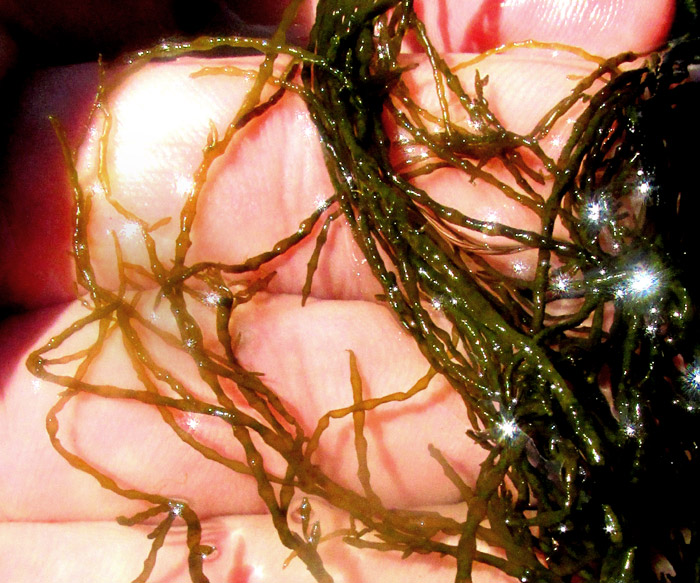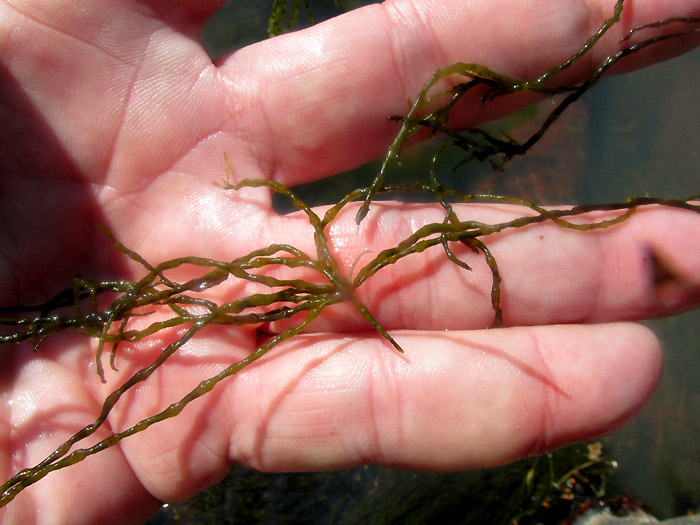Excerpts from Jim Conrad's
Naturalist Newsletter
Entry dated November 7, 2023, from notes taken at Cascadas de La Piedad waterfall 3kms NW of the community of San Pablo, municipality of Almeaco de Bonfil; bedrock of volcanic andesite; N20.1008°, W100.0041°, elevation 2360 meters (7750ft); extreme southern Querétaro state, MÉXICO
THE RED ALGA PARALEMANEA CATENATA

Even during the ongoing two-year dry period classified by the "North American Drought Monitor" as an extreme D3 drought, a small stream of clear, cold water meandered across a livestock-grazed meadow atop a bed of hard volcanic andesite rock. Just before tumbling over a high ledge to create the picturesque Cascada de La Piedad, or Piety Waterfall, the above aquatic organism, anchored to the stream's bedrock bottom, undulated like thick green hair in the cold, streaming water.

I called it an organism because it was unclear whether this was a plant or an alga. In my hand, it was somewhat similar to the Variable-leaf Watermilfoil, which is an aquatic flowering plant. However, leaves of watermilfoil species aren't segmented and nodular like the above. Also, in the above picture, note the relatively thick stem originating at the bottom, right corner and curving upwards. More slender sections branch off it, and then those sections also develop branches. Certain stems bear short, sharply tipped items which are leaves. The pictures shows a mishmash of branching stems and shorter leaves, and it takes some studying to sort things out.

Above is a short stem section from which a whorl of leaves arises, as well as some longer stem segments.

Above, leaves are backlit by the sun, revealing that bulges tend to transmit light, while the slenderer setions don't. Seeing this, I began thinking that here was another species of stonewort, which is a "macroalga." Some experts regard alga as plants, while others think of them as "protists," a grab-bag category for organisms not clearly plant, animal, fungus, bacteria or archaean.
In Texas we ran into a similar stonewort which was determined to be the genus Chara. When I search for Chara species in our highland part of central Mexico, three species have been documented. Of those species the one by far most commonly observed, and the only one looking like our organism, is Chara globulairs, often referred to as the Fragile Stonewort, which looks more or less like our organism*.
*UPDATE: In 2024 I uploaded this page's photos to iNaturalist, where user "roman_romanov" at the Komarov Botanical Institute in St. Petersburg, Russia, recognized the genus Lemanea, a kind of red algae in the class Florideophyceae. I could find only one Lemanea species documented from Mexico, which was Lemanea nodosa, and that, only once. The name Lemanea nodosa now is regarded as a synonym of PARALEMANEA CATENATA, images of which appear to match our organism.
Paralemanea catenata is not much documented, a few observations having been made in eastern and western North America, and western Europe. Elsewhere, I find only one collection, and that here' in Mexico, and also in the highland central zone.
This appears to be a pretty good find.